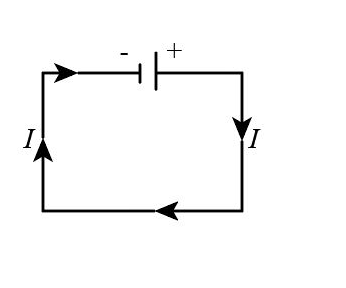
The conventional electric current flows from:
A) Higher potential to lower potential
B) Lower potential to higher potential
C) Both A and B
D) None of these
Answer
552.9k+ views
Hint: The flow of electrons in the wire in unit time is called the electric current. This occurs by the potential across the wire. The potential is the work for the movement of the electron from one position to another position.
Complete step by step solution:
The electron repels the other electron because of their same charge. The electron at the negative terminal of the wire pushes the electron in its vicinity. The electrons flow from negative terminal to positive terminal and the current flows opposite to the flow of the electron. The electron of the negative terminal pushes the other electrons if the potential between the both ends of the wire is different. This difference of the potential is called the potential difference. The potential of the positive terminal is higher than the potential of the negative terminal.
A simple diagram showing the current flow direction from +ve to -ve potential is shown below:

Therefore, the conventional current flows from higher potential to lower potential and the option (A) is correct.
Additional information:
The resistance of the wire resists the current flow in the wire. It depends on the material and dimensions of the wire. The resistance varies with the temperature. If the value of the resistance is very high then the more power dissipated in the form of heat.
Note: Be careful in identifying the positive and negative terminal of the supply because the current flows in the wire from the positive terminal to negative terminal and the direction of flow of electrons is just opposite to the current.
Complete step by step solution:
The electron repels the other electron because of their same charge. The electron at the negative terminal of the wire pushes the electron in its vicinity. The electrons flow from negative terminal to positive terminal and the current flows opposite to the flow of the electron. The electron of the negative terminal pushes the other electrons if the potential between the both ends of the wire is different. This difference of the potential is called the potential difference. The potential of the positive terminal is higher than the potential of the negative terminal.
A simple diagram showing the current flow direction from +ve to -ve potential is shown below:

Therefore, the conventional current flows from higher potential to lower potential and the option (A) is correct.
Additional information:
The resistance of the wire resists the current flow in the wire. It depends on the material and dimensions of the wire. The resistance varies with the temperature. If the value of the resistance is very high then the more power dissipated in the form of heat.
Note: Be careful in identifying the positive and negative terminal of the supply because the current flows in the wire from the positive terminal to negative terminal and the direction of flow of electrons is just opposite to the current.
Recently Updated Pages
In cricket, what is a "pink ball" primarily used for?

In cricket, what is the "new ball" phase?

In cricket, what is a "death over"?

What is the "Powerplay" in T20 cricket?

In cricket, what is a "super over"?

In cricket, what is a "tail-ender"?

Trending doubts
Why is there a time difference of about 5 hours between class 10 social science CBSE

Who was the first woman to receive Bharat Ratna?

Write a letter to the principal requesting him to grant class 10 english CBSE

What is the median of the first 10 natural numbers class 10 maths CBSE

The Equation xxx + 2 is Satisfied when x is Equal to Class 10 Maths

Who Won 36 Oscar Awards? Record Holder Revealed




